Commonwealth Bank Stakeholder Analysis and Recommendations
VerifiedAdded on 2020/05/16
|11
|2587
|28
Project
AI Summary
This project report provides a comprehensive analysis of the Commonwealth Bank (CBA), focusing on stakeholder analysis, ethical considerations, and recommendations for improvement. The report begins with an overview of key stakeholders, including directors, management, shareholders, customers, employees, and government regulators, detailing their contributions and expectations. It then delves into the behavior of these stakeholders through the lens of ethical theories such as hierarchy of ethical decision-making, stakeholder theory, descriptive theory, and normative theory. The project further presents a memorandum to CBA management, identifying the human resource department and overall culture as highest priority areas, along with specific recommendations for addressing these issues, including the application of descriptive model theory and the AAA 7 decision-making policy. Finally, a letter to the Human Resources manager of CBA is included, expressing the author's interest in a graduate role and summarizing the key findings of the research, highlighting the bank's performance and the need for ethical policy adjustments to rebuild stakeholder trust. The report offers a holistic view of CBA's operations, emphasizing the significance of ethical practices and stakeholder management for long-term success.
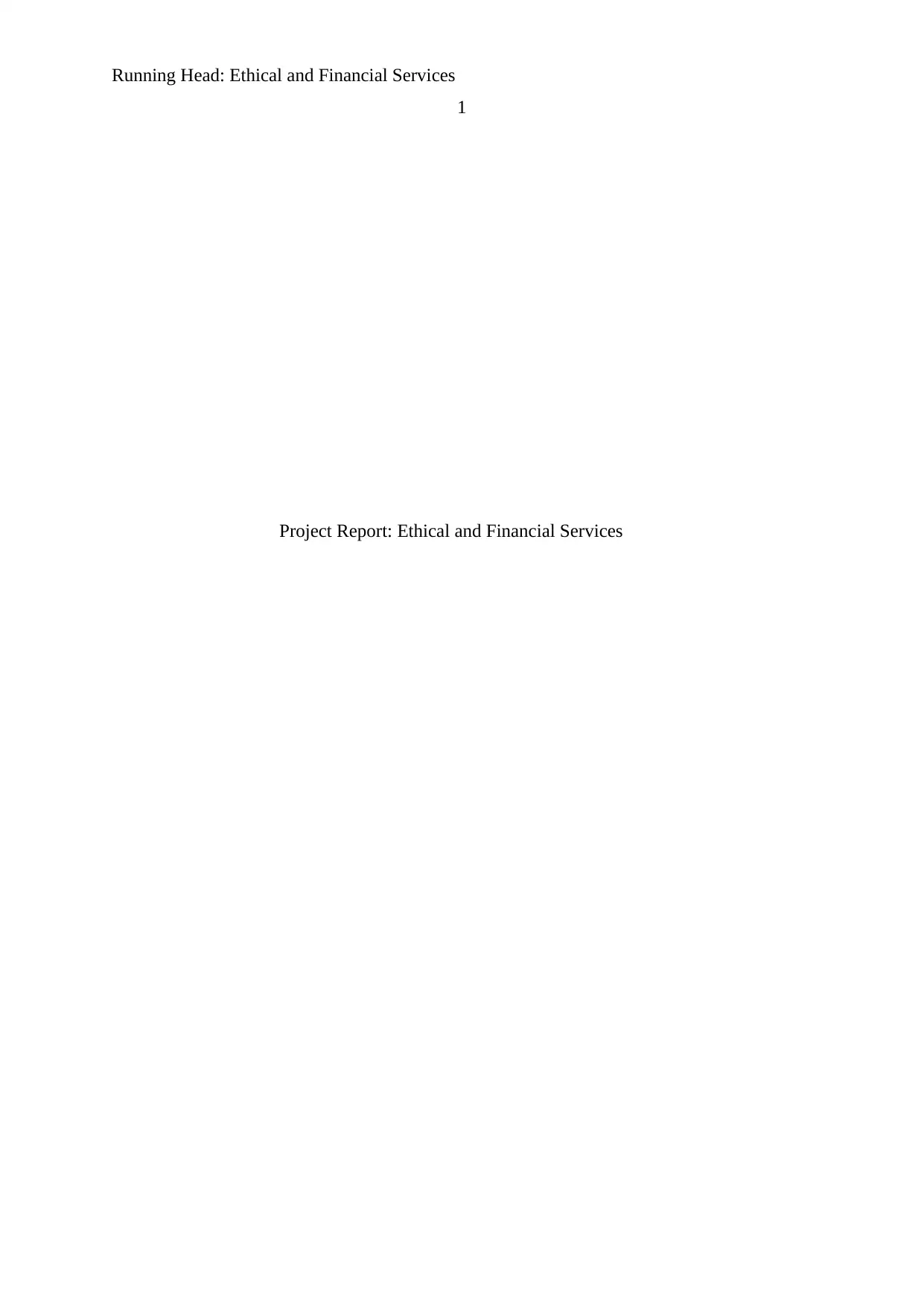
Running Head: Ethical and Financial Services
1
Project Report: Ethical and Financial Services
1
Project Report: Ethical and Financial Services
Paraphrase This Document
Need a fresh take? Get an instant paraphrase of this document with our AI Paraphraser
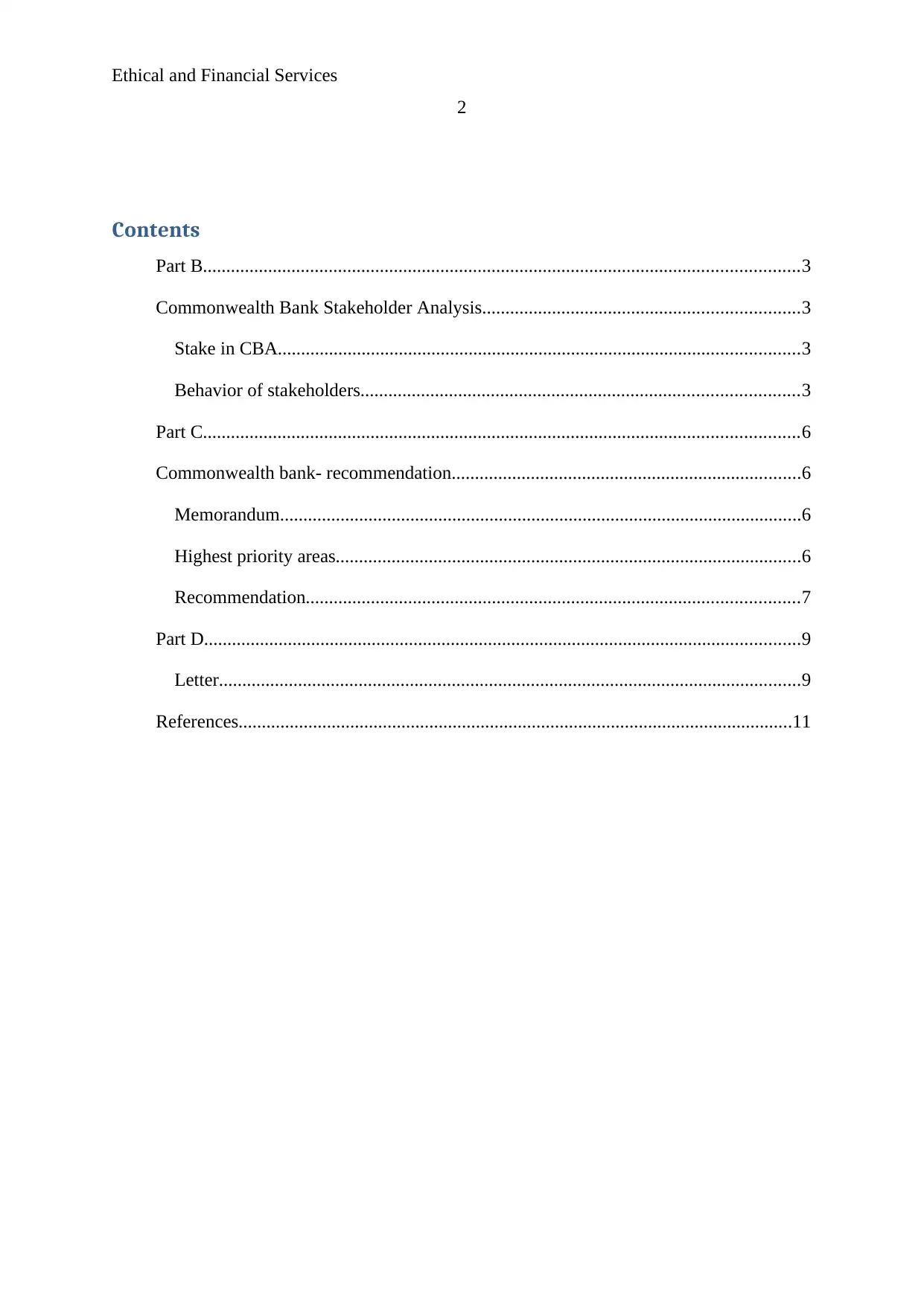
Ethical and Financial Services
2
Contents
Part B................................................................................................................................3
Commonwealth Bank Stakeholder Analysis....................................................................3
Stake in CBA................................................................................................................3
Behavior of stakeholders..............................................................................................3
Part C................................................................................................................................6
Commonwealth bank- recommendation...........................................................................6
Memorandum................................................................................................................6
Highest priority areas....................................................................................................6
Recommendation..........................................................................................................7
Part D................................................................................................................................9
Letter.............................................................................................................................9
References.......................................................................................................................11
2
Contents
Part B................................................................................................................................3
Commonwealth Bank Stakeholder Analysis....................................................................3
Stake in CBA................................................................................................................3
Behavior of stakeholders..............................................................................................3
Part C................................................................................................................................6
Commonwealth bank- recommendation...........................................................................6
Memorandum................................................................................................................6
Highest priority areas....................................................................................................6
Recommendation..........................................................................................................7
Part D................................................................................................................................9
Letter.............................................................................................................................9
References.......................................................................................................................11
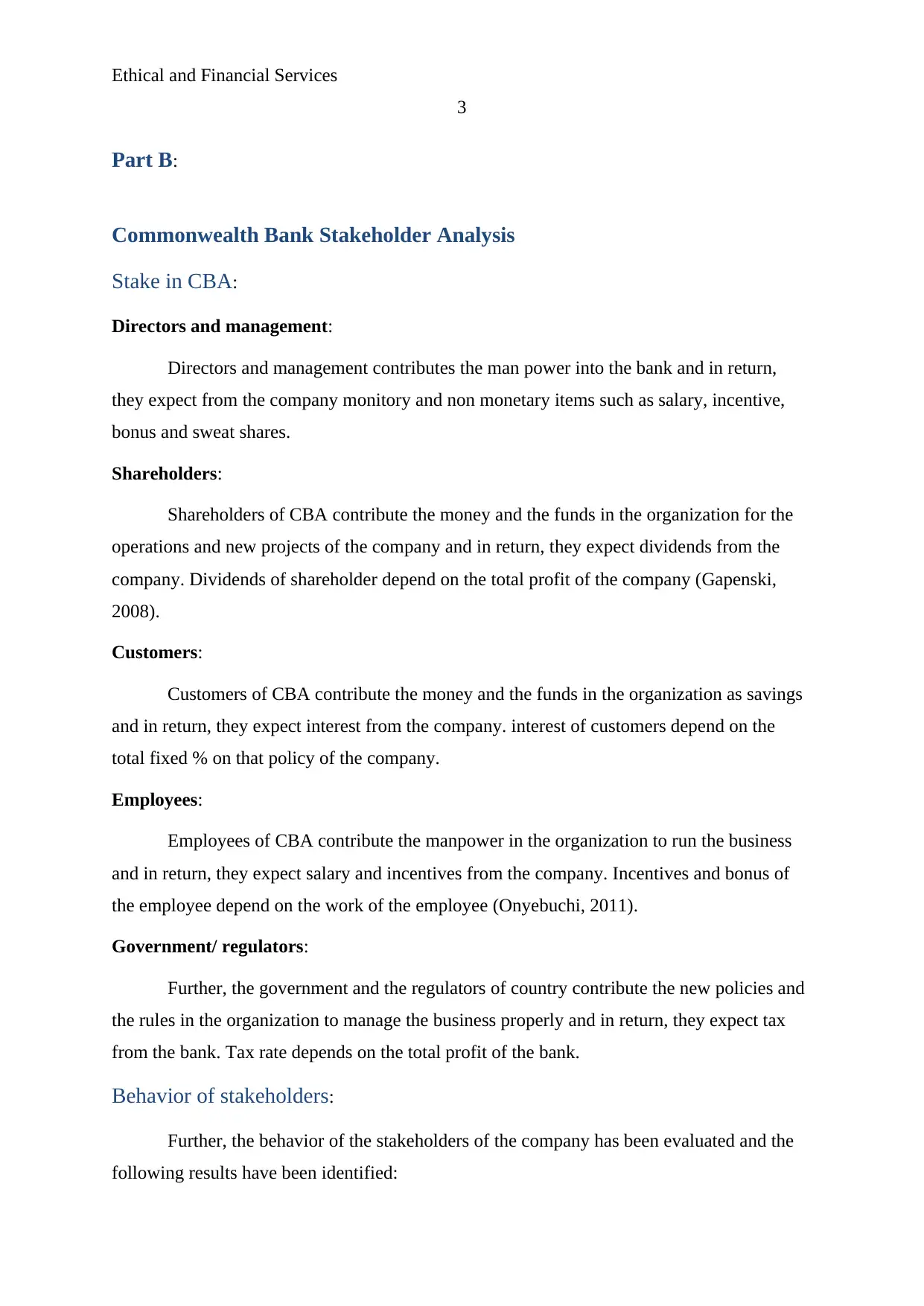
Ethical and Financial Services
3
Part B:
Commonwealth Bank Stakeholder Analysis
Stake in CBA:
Directors and management:
Directors and management contributes the man power into the bank and in return,
they expect from the company monitory and non monetary items such as salary, incentive,
bonus and sweat shares.
Shareholders:
Shareholders of CBA contribute the money and the funds in the organization for the
operations and new projects of the company and in return, they expect dividends from the
company. Dividends of shareholder depend on the total profit of the company (Gapenski,
2008).
Customers:
Customers of CBA contribute the money and the funds in the organization as savings
and in return, they expect interest from the company. interest of customers depend on the
total fixed % on that policy of the company.
Employees:
Employees of CBA contribute the manpower in the organization to run the business
and in return, they expect salary and incentives from the company. Incentives and bonus of
the employee depend on the work of the employee (Onyebuchi, 2011).
Government/ regulators:
Further, the government and the regulators of country contribute the new policies and
the rules in the organization to manage the business properly and in return, they expect tax
from the bank. Tax rate depends on the total profit of the bank.
Behavior of stakeholders:
Further, the behavior of the stakeholders of the company has been evaluated and the
following results have been identified:
3
Part B:
Commonwealth Bank Stakeholder Analysis
Stake in CBA:
Directors and management:
Directors and management contributes the man power into the bank and in return,
they expect from the company monitory and non monetary items such as salary, incentive,
bonus and sweat shares.
Shareholders:
Shareholders of CBA contribute the money and the funds in the organization for the
operations and new projects of the company and in return, they expect dividends from the
company. Dividends of shareholder depend on the total profit of the company (Gapenski,
2008).
Customers:
Customers of CBA contribute the money and the funds in the organization as savings
and in return, they expect interest from the company. interest of customers depend on the
total fixed % on that policy of the company.
Employees:
Employees of CBA contribute the manpower in the organization to run the business
and in return, they expect salary and incentives from the company. Incentives and bonus of
the employee depend on the work of the employee (Onyebuchi, 2011).
Government/ regulators:
Further, the government and the regulators of country contribute the new policies and
the rules in the organization to manage the business properly and in return, they expect tax
from the bank. Tax rate depends on the total profit of the bank.
Behavior of stakeholders:
Further, the behavior of the stakeholders of the company has been evaluated and the
following results have been identified:
⊘ This is a preview!⊘
Do you want full access?
Subscribe today to unlock all pages.

Trusted by 1+ million students worldwide
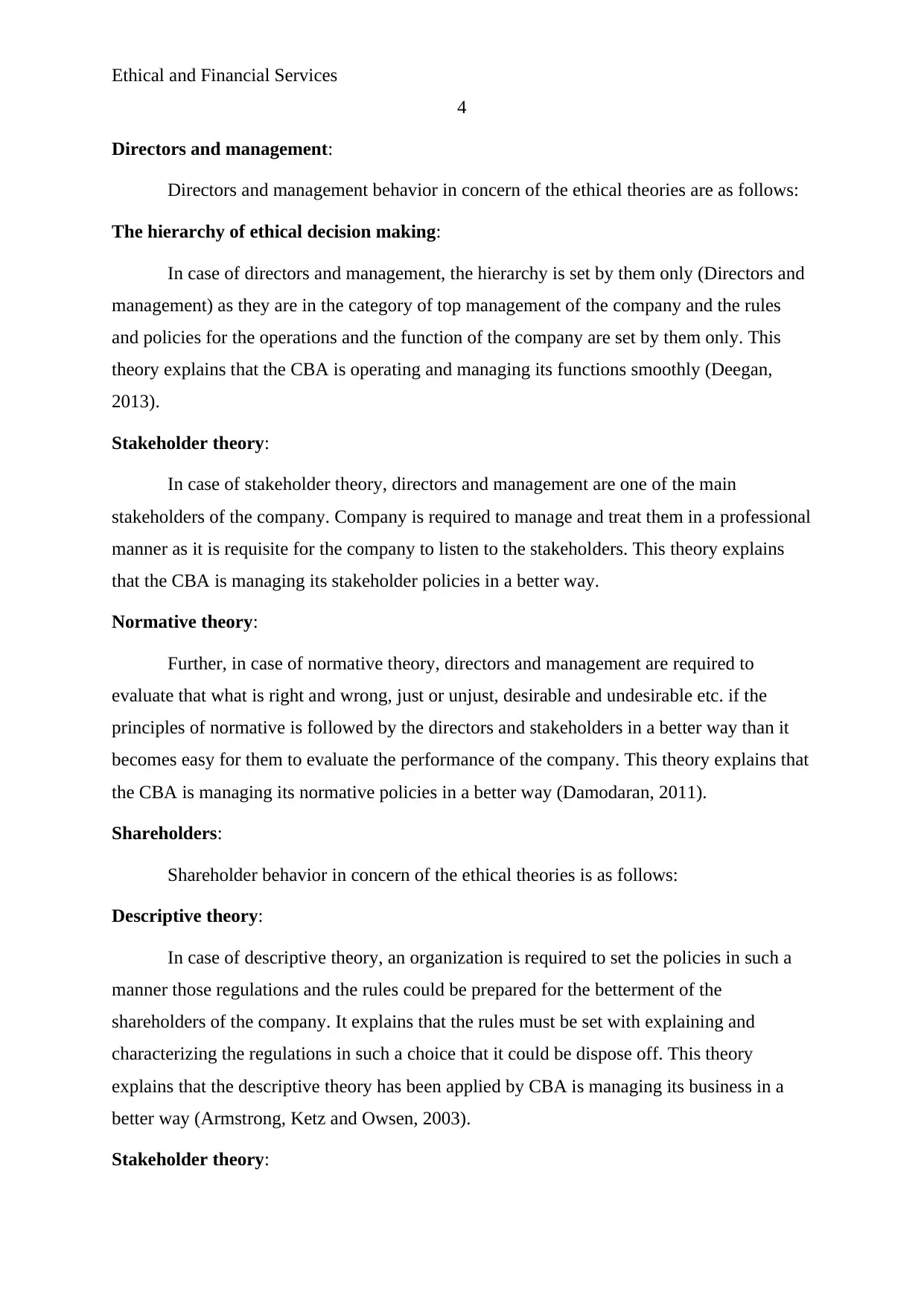
Ethical and Financial Services
4
Directors and management:
Directors and management behavior in concern of the ethical theories are as follows:
The hierarchy of ethical decision making:
In case of directors and management, the hierarchy is set by them only (Directors and
management) as they are in the category of top management of the company and the rules
and policies for the operations and the function of the company are set by them only. This
theory explains that the CBA is operating and managing its functions smoothly (Deegan,
2013).
Stakeholder theory:
In case of stakeholder theory, directors and management are one of the main
stakeholders of the company. Company is required to manage and treat them in a professional
manner as it is requisite for the company to listen to the stakeholders. This theory explains
that the CBA is managing its stakeholder policies in a better way.
Normative theory:
Further, in case of normative theory, directors and management are required to
evaluate that what is right and wrong, just or unjust, desirable and undesirable etc. if the
principles of normative is followed by the directors and stakeholders in a better way than it
becomes easy for them to evaluate the performance of the company. This theory explains that
the CBA is managing its normative policies in a better way (Damodaran, 2011).
Shareholders:
Shareholder behavior in concern of the ethical theories is as follows:
Descriptive theory:
In case of descriptive theory, an organization is required to set the policies in such a
manner those regulations and the rules could be prepared for the betterment of the
shareholders of the company. It explains that the rules must be set with explaining and
characterizing the regulations in such a choice that it could be dispose off. This theory
explains that the descriptive theory has been applied by CBA is managing its business in a
better way (Armstrong, Ketz and Owsen, 2003).
Stakeholder theory:
4
Directors and management:
Directors and management behavior in concern of the ethical theories are as follows:
The hierarchy of ethical decision making:
In case of directors and management, the hierarchy is set by them only (Directors and
management) as they are in the category of top management of the company and the rules
and policies for the operations and the function of the company are set by them only. This
theory explains that the CBA is operating and managing its functions smoothly (Deegan,
2013).
Stakeholder theory:
In case of stakeholder theory, directors and management are one of the main
stakeholders of the company. Company is required to manage and treat them in a professional
manner as it is requisite for the company to listen to the stakeholders. This theory explains
that the CBA is managing its stakeholder policies in a better way.
Normative theory:
Further, in case of normative theory, directors and management are required to
evaluate that what is right and wrong, just or unjust, desirable and undesirable etc. if the
principles of normative is followed by the directors and stakeholders in a better way than it
becomes easy for them to evaluate the performance of the company. This theory explains that
the CBA is managing its normative policies in a better way (Damodaran, 2011).
Shareholders:
Shareholder behavior in concern of the ethical theories is as follows:
Descriptive theory:
In case of descriptive theory, an organization is required to set the policies in such a
manner those regulations and the rules could be prepared for the betterment of the
shareholders of the company. It explains that the rules must be set with explaining and
characterizing the regulations in such a choice that it could be dispose off. This theory
explains that the descriptive theory has been applied by CBA is managing its business in a
better way (Armstrong, Ketz and Owsen, 2003).
Stakeholder theory:
Paraphrase This Document
Need a fresh take? Get an instant paraphrase of this document with our AI Paraphraser
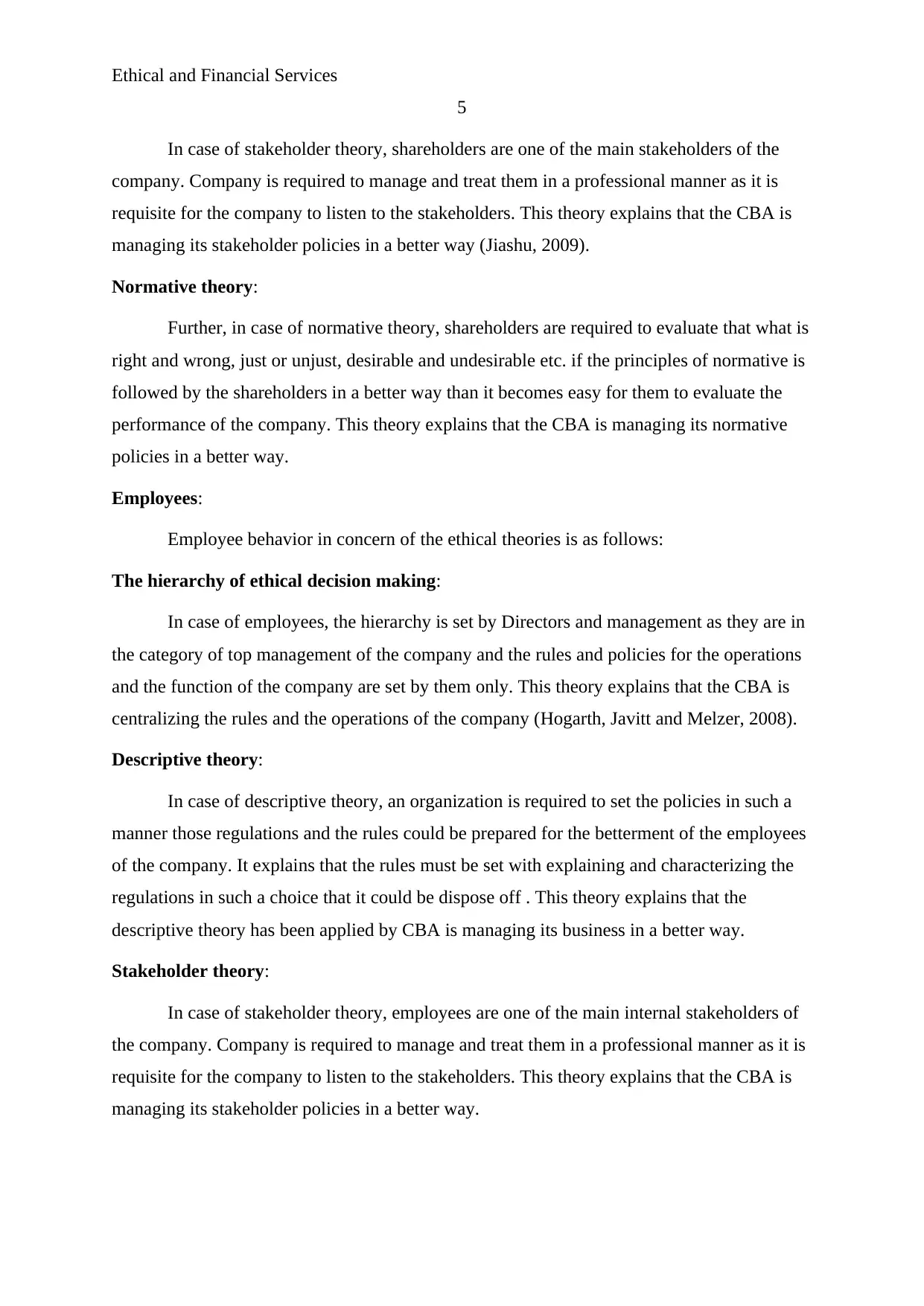
Ethical and Financial Services
5
In case of stakeholder theory, shareholders are one of the main stakeholders of the
company. Company is required to manage and treat them in a professional manner as it is
requisite for the company to listen to the stakeholders. This theory explains that the CBA is
managing its stakeholder policies in a better way (Jiashu, 2009).
Normative theory:
Further, in case of normative theory, shareholders are required to evaluate that what is
right and wrong, just or unjust, desirable and undesirable etc. if the principles of normative is
followed by the shareholders in a better way than it becomes easy for them to evaluate the
performance of the company. This theory explains that the CBA is managing its normative
policies in a better way.
Employees:
Employee behavior in concern of the ethical theories is as follows:
The hierarchy of ethical decision making:
In case of employees, the hierarchy is set by Directors and management as they are in
the category of top management of the company and the rules and policies for the operations
and the function of the company are set by them only. This theory explains that the CBA is
centralizing the rules and the operations of the company (Hogarth, Javitt and Melzer, 2008).
Descriptive theory:
In case of descriptive theory, an organization is required to set the policies in such a
manner those regulations and the rules could be prepared for the betterment of the employees
of the company. It explains that the rules must be set with explaining and characterizing the
regulations in such a choice that it could be dispose off . This theory explains that the
descriptive theory has been applied by CBA is managing its business in a better way.
Stakeholder theory:
In case of stakeholder theory, employees are one of the main internal stakeholders of
the company. Company is required to manage and treat them in a professional manner as it is
requisite for the company to listen to the stakeholders. This theory explains that the CBA is
managing its stakeholder policies in a better way.
5
In case of stakeholder theory, shareholders are one of the main stakeholders of the
company. Company is required to manage and treat them in a professional manner as it is
requisite for the company to listen to the stakeholders. This theory explains that the CBA is
managing its stakeholder policies in a better way (Jiashu, 2009).
Normative theory:
Further, in case of normative theory, shareholders are required to evaluate that what is
right and wrong, just or unjust, desirable and undesirable etc. if the principles of normative is
followed by the shareholders in a better way than it becomes easy for them to evaluate the
performance of the company. This theory explains that the CBA is managing its normative
policies in a better way.
Employees:
Employee behavior in concern of the ethical theories is as follows:
The hierarchy of ethical decision making:
In case of employees, the hierarchy is set by Directors and management as they are in
the category of top management of the company and the rules and policies for the operations
and the function of the company are set by them only. This theory explains that the CBA is
centralizing the rules and the operations of the company (Hogarth, Javitt and Melzer, 2008).
Descriptive theory:
In case of descriptive theory, an organization is required to set the policies in such a
manner those regulations and the rules could be prepared for the betterment of the employees
of the company. It explains that the rules must be set with explaining and characterizing the
regulations in such a choice that it could be dispose off . This theory explains that the
descriptive theory has been applied by CBA is managing its business in a better way.
Stakeholder theory:
In case of stakeholder theory, employees are one of the main internal stakeholders of
the company. Company is required to manage and treat them in a professional manner as it is
requisite for the company to listen to the stakeholders. This theory explains that the CBA is
managing its stakeholder policies in a better way.
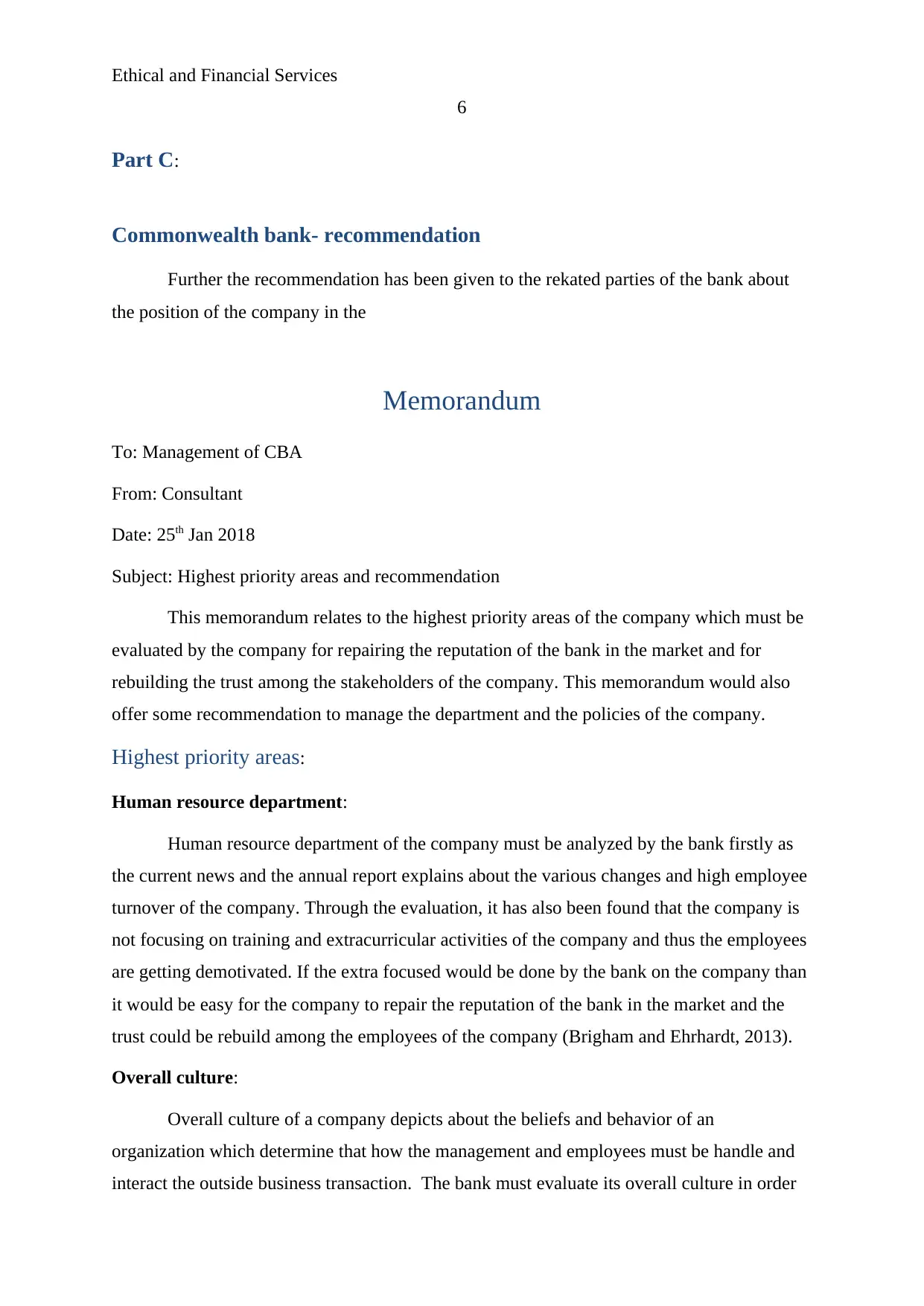
Ethical and Financial Services
6
Part C:
Commonwealth bank- recommendation
Further the recommendation has been given to the rekated parties of the bank about
the position of the company in the
Memorandum
To: Management of CBA
From: Consultant
Date: 25th Jan 2018
Subject: Highest priority areas and recommendation
This memorandum relates to the highest priority areas of the company which must be
evaluated by the company for repairing the reputation of the bank in the market and for
rebuilding the trust among the stakeholders of the company. This memorandum would also
offer some recommendation to manage the department and the policies of the company.
Highest priority areas:
Human resource department:
Human resource department of the company must be analyzed by the bank firstly as
the current news and the annual report explains about the various changes and high employee
turnover of the company. Through the evaluation, it has also been found that the company is
not focusing on training and extracurricular activities of the company and thus the employees
are getting demotivated. If the extra focused would be done by the bank on the company than
it would be easy for the company to repair the reputation of the bank in the market and the
trust could be rebuild among the employees of the company (Brigham and Ehrhardt, 2013).
Overall culture:
Overall culture of a company depicts about the beliefs and behavior of an
organization which determine that how the management and employees must be handle and
interact the outside business transaction. The bank must evaluate its overall culture in order
6
Part C:
Commonwealth bank- recommendation
Further the recommendation has been given to the rekated parties of the bank about
the position of the company in the
Memorandum
To: Management of CBA
From: Consultant
Date: 25th Jan 2018
Subject: Highest priority areas and recommendation
This memorandum relates to the highest priority areas of the company which must be
evaluated by the company for repairing the reputation of the bank in the market and for
rebuilding the trust among the stakeholders of the company. This memorandum would also
offer some recommendation to manage the department and the policies of the company.
Highest priority areas:
Human resource department:
Human resource department of the company must be analyzed by the bank firstly as
the current news and the annual report explains about the various changes and high employee
turnover of the company. Through the evaluation, it has also been found that the company is
not focusing on training and extracurricular activities of the company and thus the employees
are getting demotivated. If the extra focused would be done by the bank on the company than
it would be easy for the company to repair the reputation of the bank in the market and the
trust could be rebuild among the employees of the company (Brigham and Ehrhardt, 2013).
Overall culture:
Overall culture of a company depicts about the beliefs and behavior of an
organization which determine that how the management and employees must be handle and
interact the outside business transaction. The bank must evaluate its overall culture in order
⊘ This is a preview!⊘
Do you want full access?
Subscribe today to unlock all pages.

Trusted by 1+ million students worldwide
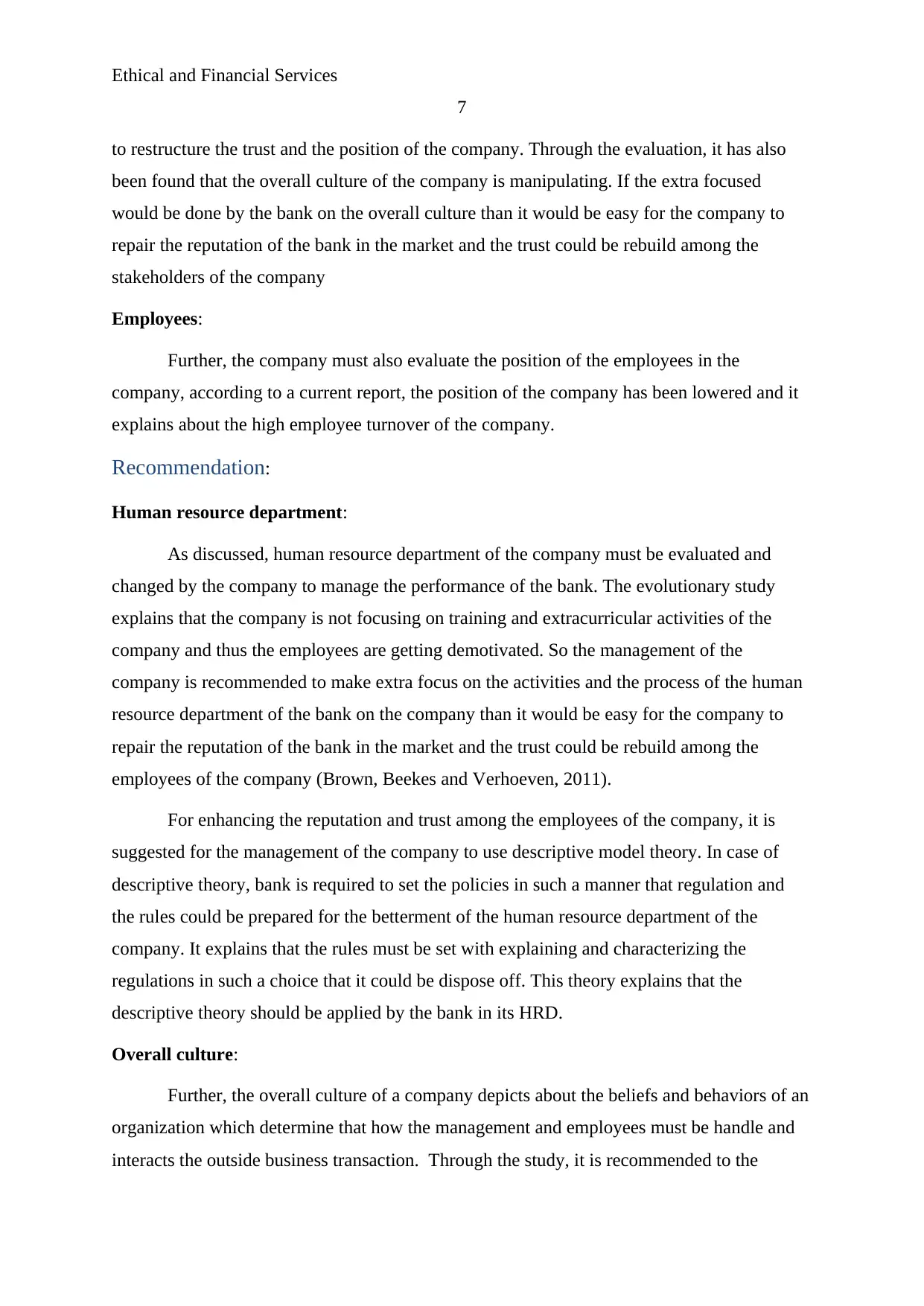
Ethical and Financial Services
7
to restructure the trust and the position of the company. Through the evaluation, it has also
been found that the overall culture of the company is manipulating. If the extra focused
would be done by the bank on the overall culture than it would be easy for the company to
repair the reputation of the bank in the market and the trust could be rebuild among the
stakeholders of the company
Employees:
Further, the company must also evaluate the position of the employees in the
company, according to a current report, the position of the company has been lowered and it
explains about the high employee turnover of the company.
Recommendation:
Human resource department:
As discussed, human resource department of the company must be evaluated and
changed by the company to manage the performance of the bank. The evolutionary study
explains that the company is not focusing on training and extracurricular activities of the
company and thus the employees are getting demotivated. So the management of the
company is recommended to make extra focus on the activities and the process of the human
resource department of the bank on the company than it would be easy for the company to
repair the reputation of the bank in the market and the trust could be rebuild among the
employees of the company (Brown, Beekes and Verhoeven, 2011).
For enhancing the reputation and trust among the employees of the company, it is
suggested for the management of the company to use descriptive model theory. In case of
descriptive theory, bank is required to set the policies in such a manner that regulation and
the rules could be prepared for the betterment of the human resource department of the
company. It explains that the rules must be set with explaining and characterizing the
regulations in such a choice that it could be dispose off. This theory explains that the
descriptive theory should be applied by the bank in its HRD.
Overall culture:
Further, the overall culture of a company depicts about the beliefs and behaviors of an
organization which determine that how the management and employees must be handle and
interacts the outside business transaction. Through the study, it is recommended to the
7
to restructure the trust and the position of the company. Through the evaluation, it has also
been found that the overall culture of the company is manipulating. If the extra focused
would be done by the bank on the overall culture than it would be easy for the company to
repair the reputation of the bank in the market and the trust could be rebuild among the
stakeholders of the company
Employees:
Further, the company must also evaluate the position of the employees in the
company, according to a current report, the position of the company has been lowered and it
explains about the high employee turnover of the company.
Recommendation:
Human resource department:
As discussed, human resource department of the company must be evaluated and
changed by the company to manage the performance of the bank. The evolutionary study
explains that the company is not focusing on training and extracurricular activities of the
company and thus the employees are getting demotivated. So the management of the
company is recommended to make extra focus on the activities and the process of the human
resource department of the bank on the company than it would be easy for the company to
repair the reputation of the bank in the market and the trust could be rebuild among the
employees of the company (Brown, Beekes and Verhoeven, 2011).
For enhancing the reputation and trust among the employees of the company, it is
suggested for the management of the company to use descriptive model theory. In case of
descriptive theory, bank is required to set the policies in such a manner that regulation and
the rules could be prepared for the betterment of the human resource department of the
company. It explains that the rules must be set with explaining and characterizing the
regulations in such a choice that it could be dispose off. This theory explains that the
descriptive theory should be applied by the bank in its HRD.
Overall culture:
Further, the overall culture of a company depicts about the beliefs and behaviors of an
organization which determine that how the management and employees must be handle and
interacts the outside business transaction. Through the study, it is recommended to the
Paraphrase This Document
Need a fresh take? Get an instant paraphrase of this document with our AI Paraphraser
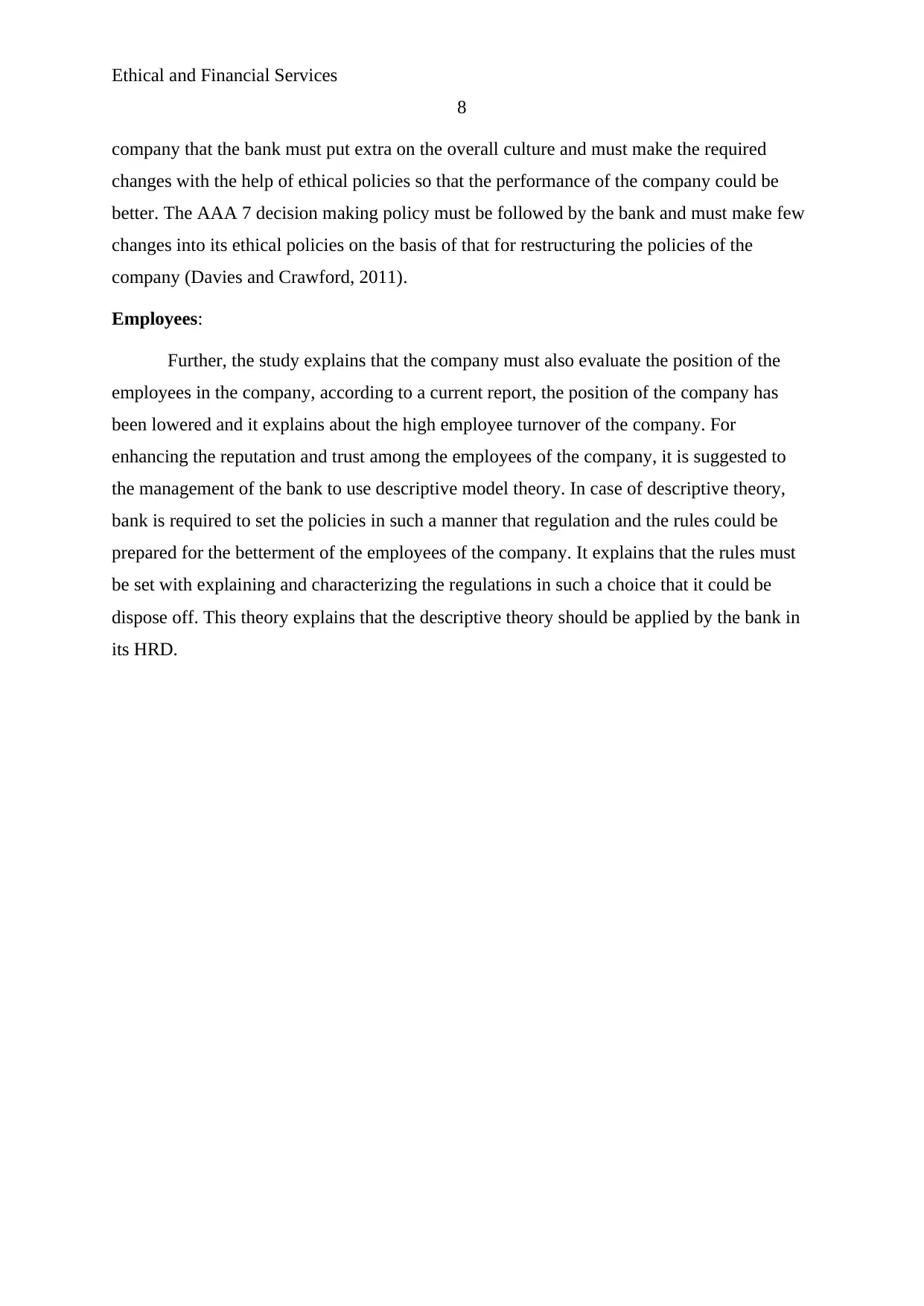
Ethical and Financial Services
8
company that the bank must put extra on the overall culture and must make the required
changes with the help of ethical policies so that the performance of the company could be
better. The AAA 7 decision making policy must be followed by the bank and must make few
changes into its ethical policies on the basis of that for restructuring the policies of the
company (Davies and Crawford, 2011).
Employees:
Further, the study explains that the company must also evaluate the position of the
employees in the company, according to a current report, the position of the company has
been lowered and it explains about the high employee turnover of the company. For
enhancing the reputation and trust among the employees of the company, it is suggested to
the management of the bank to use descriptive model theory. In case of descriptive theory,
bank is required to set the policies in such a manner that regulation and the rules could be
prepared for the betterment of the employees of the company. It explains that the rules must
be set with explaining and characterizing the regulations in such a choice that it could be
dispose off. This theory explains that the descriptive theory should be applied by the bank in
its HRD.
8
company that the bank must put extra on the overall culture and must make the required
changes with the help of ethical policies so that the performance of the company could be
better. The AAA 7 decision making policy must be followed by the bank and must make few
changes into its ethical policies on the basis of that for restructuring the policies of the
company (Davies and Crawford, 2011).
Employees:
Further, the study explains that the company must also evaluate the position of the
employees in the company, according to a current report, the position of the company has
been lowered and it explains about the high employee turnover of the company. For
enhancing the reputation and trust among the employees of the company, it is suggested to
the management of the bank to use descriptive model theory. In case of descriptive theory,
bank is required to set the policies in such a manner that regulation and the rules could be
prepared for the betterment of the employees of the company. It explains that the rules must
be set with explaining and characterizing the regulations in such a choice that it could be
dispose off. This theory explains that the descriptive theory should be applied by the bank in
its HRD.
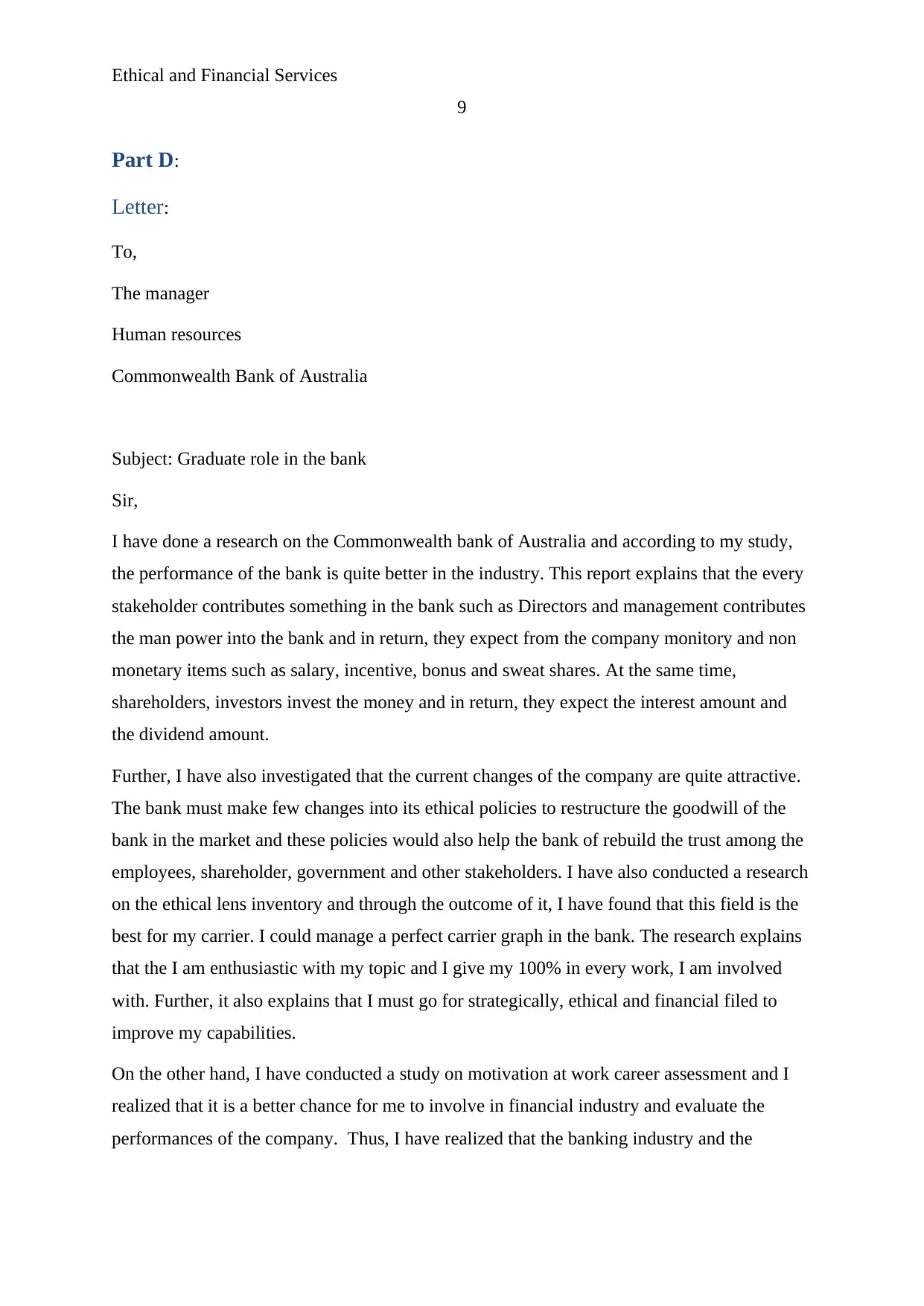
Ethical and Financial Services
9
Part D:
Letter:
To,
The manager
Human resources
Commonwealth Bank of Australia
Subject: Graduate role in the bank
Sir,
I have done a research on the Commonwealth bank of Australia and according to my study,
the performance of the bank is quite better in the industry. This report explains that the every
stakeholder contributes something in the bank such as Directors and management contributes
the man power into the bank and in return, they expect from the company monitory and non
monetary items such as salary, incentive, bonus and sweat shares. At the same time,
shareholders, investors invest the money and in return, they expect the interest amount and
the dividend amount.
Further, I have also investigated that the current changes of the company are quite attractive.
The bank must make few changes into its ethical policies to restructure the goodwill of the
bank in the market and these policies would also help the bank of rebuild the trust among the
employees, shareholder, government and other stakeholders. I have also conducted a research
on the ethical lens inventory and through the outcome of it, I have found that this field is the
best for my carrier. I could manage a perfect carrier graph in the bank. The research explains
that the I am enthusiastic with my topic and I give my 100% in every work, I am involved
with. Further, it also explains that I must go for strategically, ethical and financial filed to
improve my capabilities.
On the other hand, I have conducted a study on motivation at work career assessment and I
realized that it is a better chance for me to involve in financial industry and evaluate the
performances of the company. Thus, I have realized that the banking industry and the
9
Part D:
Letter:
To,
The manager
Human resources
Commonwealth Bank of Australia
Subject: Graduate role in the bank
Sir,
I have done a research on the Commonwealth bank of Australia and according to my study,
the performance of the bank is quite better in the industry. This report explains that the every
stakeholder contributes something in the bank such as Directors and management contributes
the man power into the bank and in return, they expect from the company monitory and non
monetary items such as salary, incentive, bonus and sweat shares. At the same time,
shareholders, investors invest the money and in return, they expect the interest amount and
the dividend amount.
Further, I have also investigated that the current changes of the company are quite attractive.
The bank must make few changes into its ethical policies to restructure the goodwill of the
bank in the market and these policies would also help the bank of rebuild the trust among the
employees, shareholder, government and other stakeholders. I have also conducted a research
on the ethical lens inventory and through the outcome of it, I have found that this field is the
best for my carrier. I could manage a perfect carrier graph in the bank. The research explains
that the I am enthusiastic with my topic and I give my 100% in every work, I am involved
with. Further, it also explains that I must go for strategically, ethical and financial filed to
improve my capabilities.
On the other hand, I have conducted a study on motivation at work career assessment and I
realized that it is a better chance for me to involve in financial industry and evaluate the
performances of the company. Thus, I have realized that the banking industry and the
⊘ This is a preview!⊘
Do you want full access?
Subscribe today to unlock all pages.

Trusted by 1+ million students worldwide
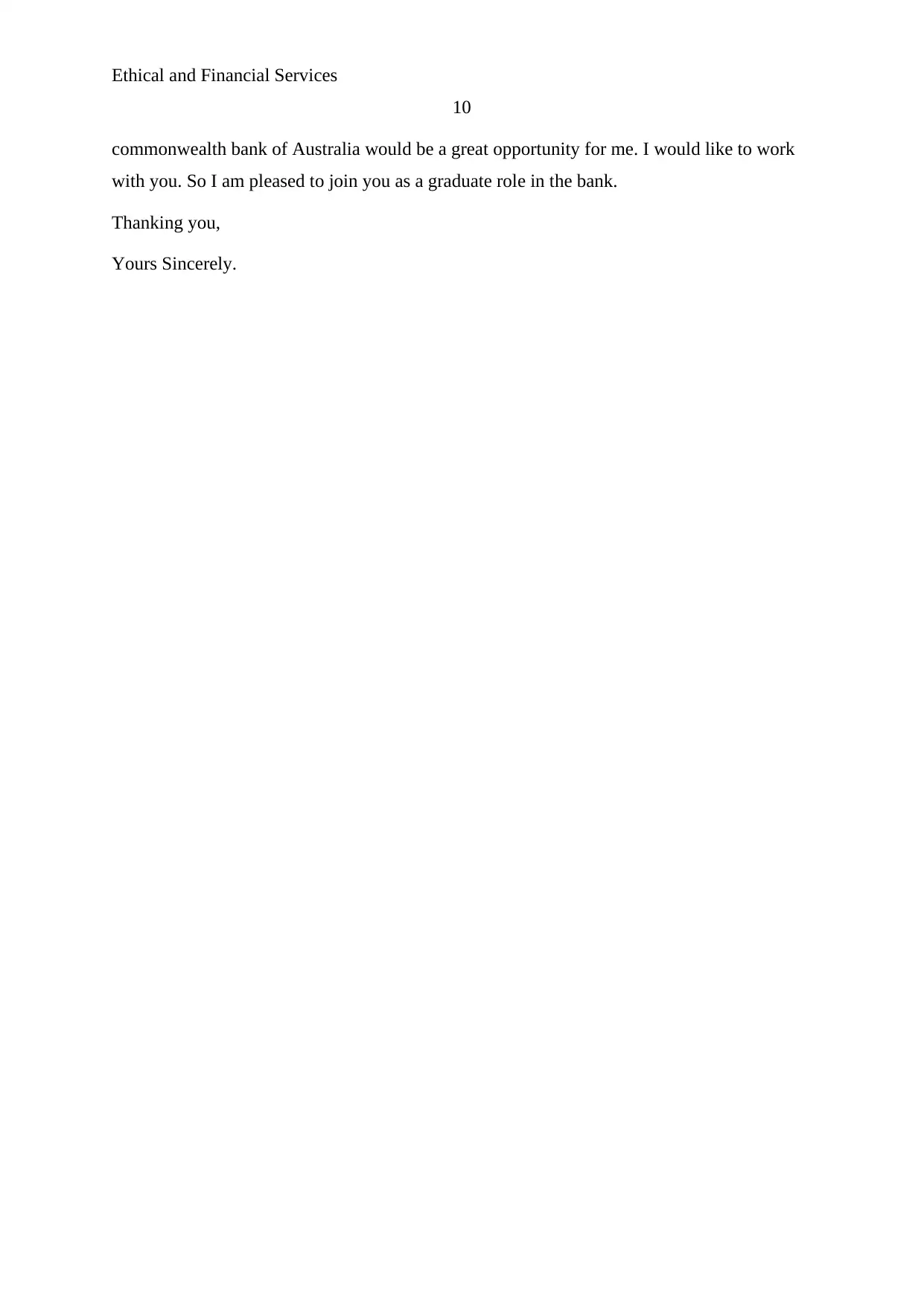
Ethical and Financial Services
10
commonwealth bank of Australia would be a great opportunity for me. I would like to work
with you. So I am pleased to join you as a graduate role in the bank.
Thanking you,
Yours Sincerely.
10
commonwealth bank of Australia would be a great opportunity for me. I would like to work
with you. So I am pleased to join you as a graduate role in the bank.
Thanking you,
Yours Sincerely.
Paraphrase This Document
Need a fresh take? Get an instant paraphrase of this document with our AI Paraphraser
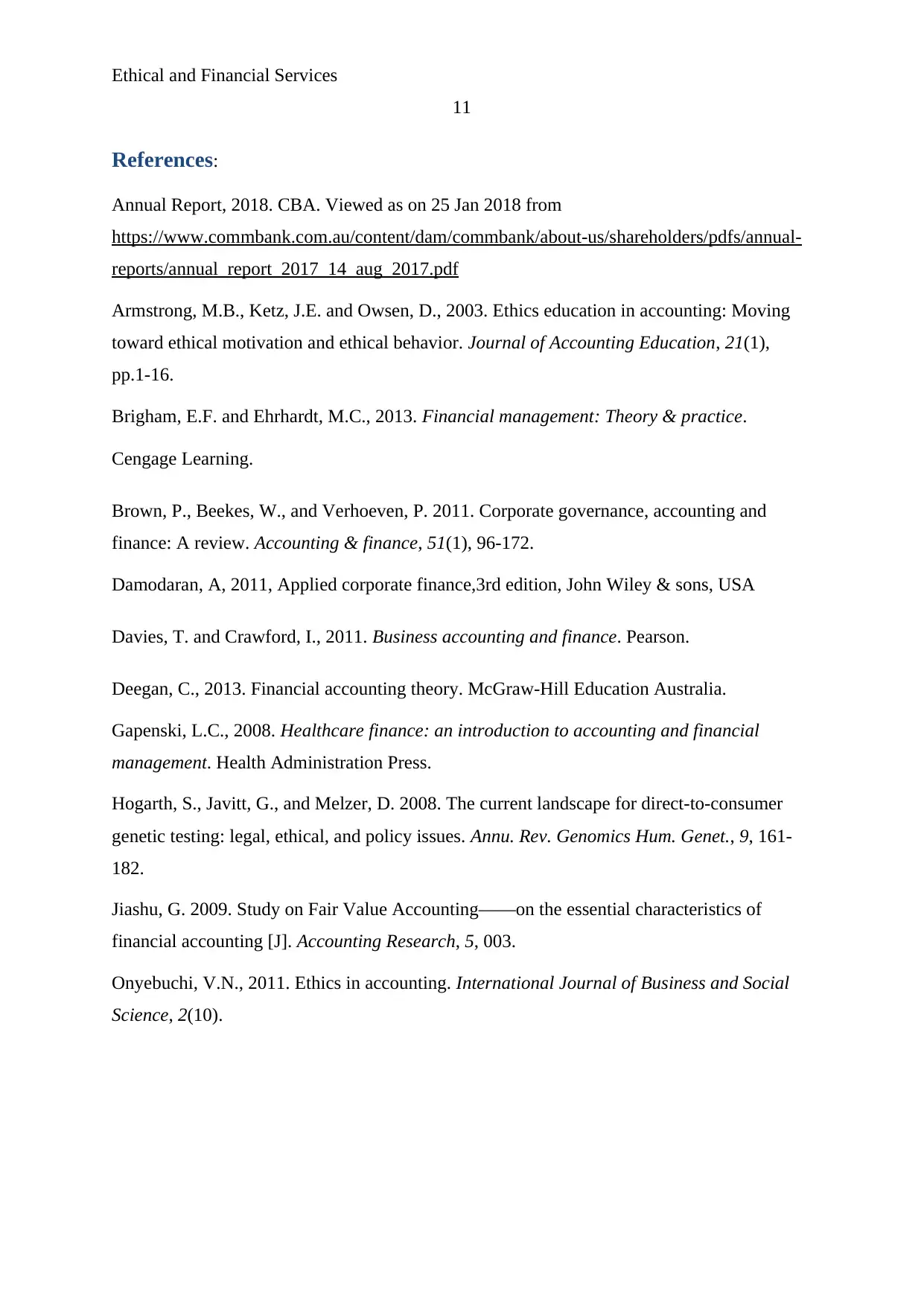
Ethical and Financial Services
11
References:
Annual Report, 2018. CBA. Viewed as on 25 Jan 2018 from
https://www.commbank.com.au/content/dam/commbank/about-us/shareholders/pdfs/annual-
reports/annual_report_2017_14_aug_2017.pdf
Armstrong, M.B., Ketz, J.E. and Owsen, D., 2003. Ethics education in accounting: Moving
toward ethical motivation and ethical behavior. Journal of Accounting Education, 21(1),
pp.1-16.
Brigham, E.F. and Ehrhardt, M.C., 2013. Financial management: Theory & practice.
Cengage Learning.
Brown, P., Beekes, W., and Verhoeven, P. 2011. Corporate governance, accounting and
finance: A review. Accounting & finance, 51(1), 96-172.
Damodaran, A, 2011, Applied corporate finance,3rd edition, John Wiley & sons, USA
Davies, T. and Crawford, I., 2011. Business accounting and finance. Pearson.
Deegan, C., 2013. Financial accounting theory. McGraw-Hill Education Australia.
Gapenski, L.C., 2008. Healthcare finance: an introduction to accounting and financial
management. Health Administration Press.
Hogarth, S., Javitt, G., and Melzer, D. 2008. The current landscape for direct-to-consumer
genetic testing: legal, ethical, and policy issues. Annu. Rev. Genomics Hum. Genet., 9, 161-
182.
Jiashu, G. 2009. Study on Fair Value Accounting——on the essential characteristics of
financial accounting [J]. Accounting Research, 5, 003.
Onyebuchi, V.N., 2011. Ethics in accounting. International Journal of Business and Social
Science, 2(10).
11
References:
Annual Report, 2018. CBA. Viewed as on 25 Jan 2018 from
https://www.commbank.com.au/content/dam/commbank/about-us/shareholders/pdfs/annual-
reports/annual_report_2017_14_aug_2017.pdf
Armstrong, M.B., Ketz, J.E. and Owsen, D., 2003. Ethics education in accounting: Moving
toward ethical motivation and ethical behavior. Journal of Accounting Education, 21(1),
pp.1-16.
Brigham, E.F. and Ehrhardt, M.C., 2013. Financial management: Theory & practice.
Cengage Learning.
Brown, P., Beekes, W., and Verhoeven, P. 2011. Corporate governance, accounting and
finance: A review. Accounting & finance, 51(1), 96-172.
Damodaran, A, 2011, Applied corporate finance,3rd edition, John Wiley & sons, USA
Davies, T. and Crawford, I., 2011. Business accounting and finance. Pearson.
Deegan, C., 2013. Financial accounting theory. McGraw-Hill Education Australia.
Gapenski, L.C., 2008. Healthcare finance: an introduction to accounting and financial
management. Health Administration Press.
Hogarth, S., Javitt, G., and Melzer, D. 2008. The current landscape for direct-to-consumer
genetic testing: legal, ethical, and policy issues. Annu. Rev. Genomics Hum. Genet., 9, 161-
182.
Jiashu, G. 2009. Study on Fair Value Accounting——on the essential characteristics of
financial accounting [J]. Accounting Research, 5, 003.
Onyebuchi, V.N., 2011. Ethics in accounting. International Journal of Business and Social
Science, 2(10).
1 out of 11
Related Documents
Your All-in-One AI-Powered Toolkit for Academic Success.
+13062052269
info@desklib.com
Available 24*7 on WhatsApp / Email
![[object Object]](/_next/static/media/star-bottom.7253800d.svg)
Unlock your academic potential
Copyright © 2020–2025 A2Z Services. All Rights Reserved. Developed and managed by ZUCOL.





